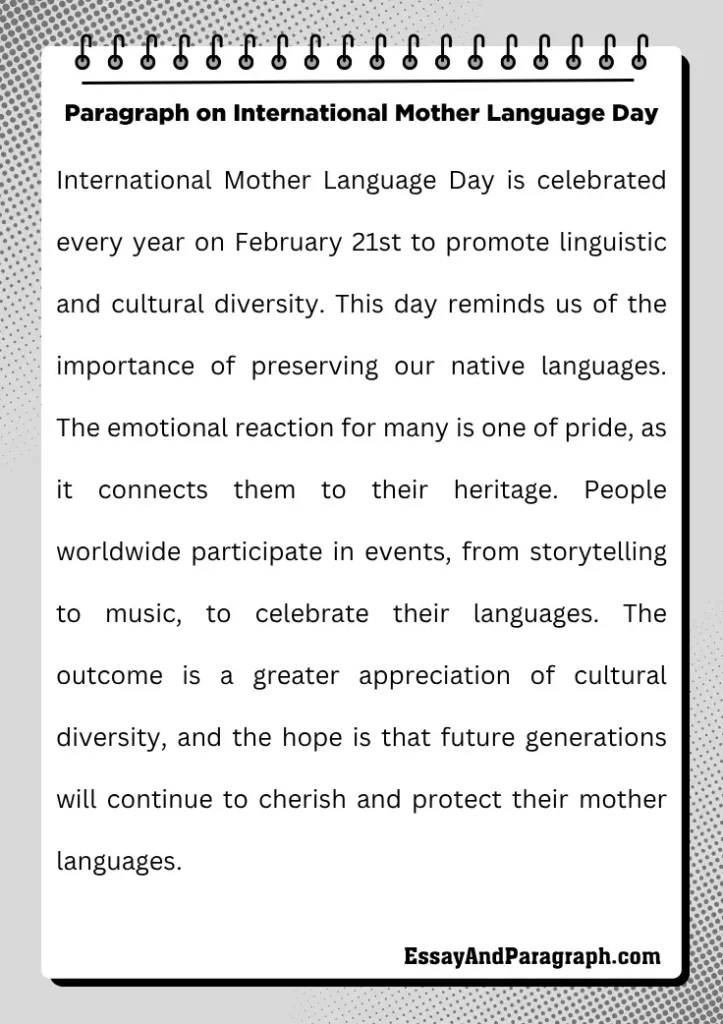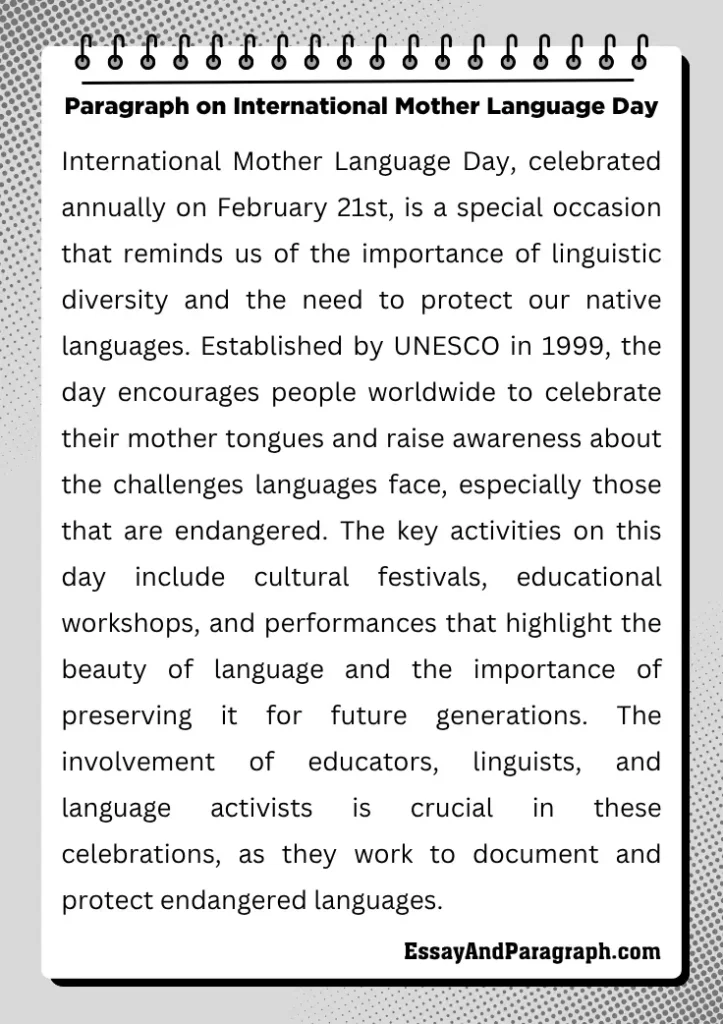International Mother Language Day is a time to celebrate the beauty and diversity of languages worldwide. It’s a day to reflect on how language connects us to our cultures, identities, and communities. I remember the first time I really understood the importance of my own mother tongue and how it shapes who I am. Whether it’s a language that brings back childhood memories or one that connects generations, International Mother Language Day highlights the need to preserve our native languages. In this article, we’ll explore what makes this day so special and why we should cherish our mother languages.
Paragraph on International Mother Language Day – 100 words
International Mother Language Day is celebrated every year on February 21st to promote linguistic and cultural diversity. This day reminds us of the importance of preserving our native languages. The emotional reaction for many is one of pride, as it connects them to their heritage. People worldwide participate in events, from storytelling to music, to celebrate their languages. The outcome is a greater appreciation of cultural diversity, and the hope is that future generations will continue to cherish and protect their mother languages.
 Paragraph on International Mother Language Day
Paragraph on International Mother Language Day
Paragraph on International Mother Language Day – 150 words
International Mother Language Day is a significant occasion celebrated globally on February 21st. It was created by UNESCO in 1999 to raise awareness about the importance of language in our lives. It’s a day that brings about mixed emotions, from pride to sadness, as we reflect on languages that are endangered or extinct. During this day, people from different cultures come together to share their languages through poetry, storytelling, and music. Key events include conferences and local celebrations where speakers share their linguistic heritage. The goal of International Mother Language Day is not only to celebrate the diversity of languages but also to highlight the need to preserve them. We hope that this day sparks a commitment to protecting endangered languages and keeping them alive for future generations.
Paragraph on International Mother Language Day – 200 words
International Mother Language Day holds a special place in my heart, as it allows us to reflect on how languages shape our identity. Observed annually on February 21st, the day reminds us that every language carries with it centuries of culture, history, and tradition. The day was established by UNESCO in 1999 to promote linguistic diversity and raise awareness about the challenges languages face, particularly those that are endangered. When I think of my own mother tongue, I feel a deep connection to my heritage. I’m sure many others feel the same way, whether it’s through the stories, songs, or customs passed down through generations.
Throughout the world, people celebrate this day by participating in activities such as language fairs, traditional performances, and educational workshops. It’s a day when we honor the unique qualities of each language, and the key people involved are educators, linguists, and communities who actively work to preserve their languages. The outcomes of International Mother Language Day are both emotional and practical. We see an increase in efforts to safeguard endangered languages and a growing appreciation for linguistic diversity. Looking forward, I believe this day will continue to inspire future generations to celebrate and protect their mother languages.
Paragraph on International Mother Language Day – 250 words
International Mother Language Day is more than just a day of celebration; it’s a day to honor the very essence of our identities and the languages that shape them. Every year, on February 21st, people around the world gather to recognize the importance of their mother tongues. This day serves as a reminder of the emotional connection we have with the languages we speak and the role they play in preserving our cultural heritage. It’s a reminder that language is not just a means of communication but a powerful tool for building community and fostering understanding.
The main activity during International Mother Language Day is the celebration of linguistic diversity through events that include storytelling, cultural performances, and educational seminars. Schools, universities, and local organizations often host activities to encourage young people to appreciate their native languages. The key people involved are educators, activists, and community leaders who work tirelessly to ensure that languages—especially those that are endangered—remain alive. One notable outcome of this day is the renewed global effort to document and preserve languages that are at risk of disappearing. By sharing stories and traditions in different languages, we create a lasting impact on the way we view and interact with language.
Looking ahead, International Mother Language Day will continue to inspire conversations about the importance of language preservation. The day serves as a call to action for all of us to safeguard our linguistic heritage and ensure that future generations can experience the richness of their mother languages.
Paragraph on International Mother Language Day – 300 words
International Mother Language Day is not just about words; it’s about the cultural and emotional connections that shape us. Celebrated every year on February 21st, it highlights the importance of linguistic diversity and raises awareness about the preservation of native languages. When I think about my mother tongue, I remember how it has been a bridge to my culture, traditions, and memories of childhood. The day holds a significant emotional weight for many, evoking a sense of pride in their heritage. For others, it can be a time of reflection on the languages that are disappearing and the urgent need for preservation.
Each year, communities across the world celebrate by organizing events such as cultural festivals, poetry readings, and language workshops. People gather to share their stories, songs, and customs, creating a collective celebration of linguistic diversity. The key figures involved are language activists, educators, and linguists, who work tirelessly to document and preserve endangered languages. These efforts are critical in maintaining linguistic diversity, as some languages are disappearing at an alarming rate. UNESCO has declared that over 40% of the world’s languages are endangered, and International Mother Language Day aims to raise awareness of this issue.
The outcome of International Mother Language Day is a growing global movement to preserve and protect languages. The significance of this day extends beyond celebration—it’s a call to action. As we continue to honor our native languages, we are also ensuring that the cultures, traditions, and knowledge they carry are not lost. In the future, I hope that International Mother Language Day continues to inspire more people to take an active role in preserving the languages that make our world so wonderfully diverse.
FAQs on International Mother Language Day
1. Why do we celebrate International Mother Language Day?
International Mother Language Day is celebrated to raise awareness about linguistic diversity and the importance of preserving native languages. It highlights the cultural significance of language and the need to protect endangered languages from extinction. This day encourages individuals and communities to reflect on their cultural identity and the vital role language plays in preserving traditions and histories.
2. When is International Mother Language Day observed?
International Mother Language Day is observed every year on February 21st. This date was chosen to commemorate the 1952 student protests in Bangladesh, where students lost their lives while demanding that their language be recognized as an official language. Since then, this day has become a global reminder of the importance of linguistic diversity.
3. How can we celebrate International Mother Language Day?
You can celebrate International Mother Language Day by participating in or organizing events such as cultural performances, storytelling sessions, language workshops, or poetry readings. Schools and communities often host activities to help people learn about and appreciate their native languages, encouraging the younger generation to value their linguistic heritage.
4. What are the benefits of celebrating International Mother Language Day?
Celebrating this day helps promote cultural pride and linguistic diversity. It brings attention to the importance of preserving native languages and fosters a greater appreciation for the richness that different languages bring to the world. Additionally, it raises awareness about the challenges that many languages face in becoming endangered, inspiring action to protect them.
5. Who is involved in International Mother Language Day celebrations?
Various groups are involved in International Mother Language Day celebrations, including educators, linguists, language activists, community leaders, and students. These individuals play an essential role in promoting the value of languages, documenting endangered languages, and fostering an appreciation for linguistic diversity.
6. Why is preserving our mother language important?
Preserving our mother language is important because it carries cultural, historical, and traditional knowledge that connects us to our heritage. A language is not just a tool for communication; it also shapes how we think, feel, and interact with others. When languages are lost, a significant part of cultural identity and heritage is lost as well. By protecting our languages, we ensure that future generations can continue to connect with their roots.
 Paragraph on International Mother Language Day
Paragraph on International Mother Language Day
Summary on International Mother Language Day
International Mother Language Day, celebrated annually on February 21st, is a special occasion that reminds us of the importance of linguistic diversity and the need to protect our native languages. Established by UNESCO in 1999, the day encourages people worldwide to celebrate their mother tongues and raise awareness about the challenges languages face, especially those that are endangered. The key activities on this day include cultural festivals, educational workshops, and performances that highlight the beauty of language and the importance of preserving it for future generations. The involvement of educators, linguists, and language activists is crucial in these celebrations, as they work to document and protect endangered languages.

